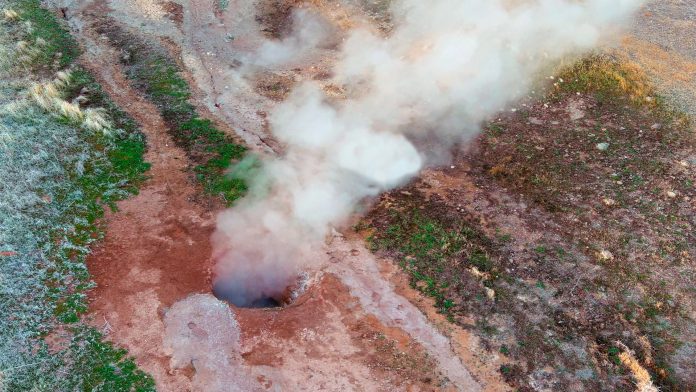Fraunhofer scientists have now developed an innovative tool that enables additional branches to be drilled off the main geothermal well. This decreases the risk of dry boreholes and improves the output.
Geothermal energy
Geothermal energy is an inexhaustible energy source that can play a significant role in the fight against climate change. Hot water from reservoirs, fissures and cracks can be found deep in the Earth’s crust, which is about 30 kilometres thick. The water at a depth of 5000 meters is already 200°C hot. In geothermal applications, it is pumped up using a production well. This water can then be used to power steam turbines to generate electricity or to heat buildings via heat pump systems. The cooled water flows back into the Earth’s crust via a second well — the injection well — where it is heated up again in the hot rock to complete the cycle.
However, the geothermal wells, which reach several thousand meters deep, entail both significant costs and risks at the same time. There is a 30% risk of scientists being wrong and finding nothing (what experts call the exploration risk). That is what the experts at the Fraunhofer Research Institution for Energy Infrastructures and Geothermal Systems (IEG) in Bochum aim to change.
Their intention is to use a mini-drill to perforate the area around the borehole in a radius of 50 meters and hydraulically connect the surrounding water-filled cracks and fractures to the borehole. This allows the water to flow into the production well from where it can be pumped up to start the cycle that creates the geothermal energy.
Secondary drilling
The micro turbine drilling (MTD) technology used in this geothermal experiment was developed by Niklas Geißler, who performs research at the Fraunhofer IEG in Bochum and the Fraunhofer-Chalmers Re-search Centre (FCC) for Industrial Mathematics in Sweden. “Wells that reach several kilometres into the Earth’s crust cost millions of euros. Additional branches from the main well using MTD increase the catchment area for hot water and the exploration risk significantly decreases,” explained Geißler.
Scientists insist that the key to success in this geothermal experiment is compact MTD, which is equipped with a special drill bit. It is very small, measuring just 3.6 centimetres in diameter and 10 centimetres in length. The micro turbine is attached to a high-pressure hose, through which it is powered by up to 200 litres of water per minute at an inlet pressure of about 100 bar, which makes the bit rotate. The bit consists of a tungsten carbide matrix with incorporated diamond grains and grinds into the rock at up to 80,000 rotations per minute. Therefore, it is especially suited for hard, crystalline rocks like granite.
Additionally, the drill bit used in during the MTD is stronger than steel. This was an important factor scientists gad to consider because wells are usually lined with steel casing for better stability. Without changing the drilling tool, the MTD can first drill the steel casing and then the rock in a single step.
“We can drill two to three meters in one hour. The water that powers the micro turbine serves as both a coolant, so the drill doesn’t get too hot, and flushes the hole to remove the drill cuttings,” Geißler explained. There have been similar technologies using pressurized water in the past, such as radial jet drilling. However, until now only soft rock could be drilled using those technologies. For geothermal energy in particular a method is needed to drill through the hard rock to gain access to where the geothermal reservoirs are often found.
One of the challenges in this process is to deflect the micro drilling turbine out of the main well and drive it into the surrounding rock at a relatively large working angle. That is why the IEG researchers have developed a special deflection device. Using this “deflector shoe,” the compact tool can be guided out of the main well at an angle of about 45°. Thus, the drilling tool opens new cracks and fissures with hot water around the main geothermal well. Using hydraulic pressure means that when the water is pumped up, the water flows out of the cracks and fissures and into the main well.
“During the last months, we successfully demonstrated the technology in a proof of concept at the Bedretto Underground Laboratory (BUL) in Switzerland, near the Gotthard tunnel. The process is already very stable and reliable,” Geißler commented.
Future development
Since March 2021, the German Federal Ministry for Economic Affairs and Energy has contributed over 430,000 euros towards Geißler’s project after taking note of the potential benefits that can arise from harnessing geothermal energy.
As a result, Geißler and his team can move ahead with the next steps of their project, which is to record the drilling noises during the geothermal extraction. The sound of the micro drilling turbine, whose blades emit a characteristic pulse pattern during rotation, can also serve as an acoustic reference for the analysis. By analysing the audio recordings, it is possible to determine whether the drill is rotating at the right speed, is stuck or is even running dry. The noise is transmitted as structure-borne sound to the steel pipes and recorded on the surface.
The technology is not only useful for geothermal applications. “In general, the MTD can be used in any deep drilling where it is important to explore the surrounding area of a well with potentially heterogeneous rock types, such as for the oil and gas industry. In the geotechnology or tunnel construction fields. For example, this micro drilling technology can be used to drill anchor holes in hard-to-reach areas where the amount of available space precludes the usage of conventional equipment,” explained Geißler.
However, the priority for this technology is certainly the extraction of geothermal energy. Experts estimate that the number of geothermal power plants in Europe will double over the next five to eight years. Micro turbine drilling from the Fraunhofer IEG can play a significant role in making production wells less risky, less costly and even more efficient, not to mention the contribution the technology would have towards aiding climate change.









